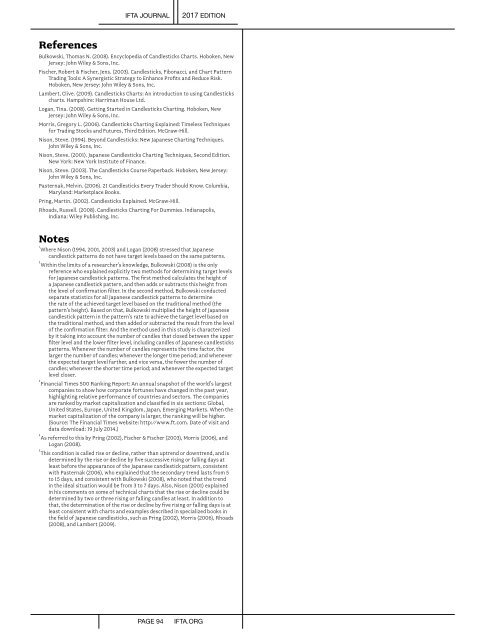You also want an ePaper? Increase the reach of your titles
YUMPU automatically turns print PDFs into web optimized ePapers that Google loves.
IFTA JOURNAL<br />
2017 EDITION<br />
References<br />
Bulkowski, Thomas N. (2008). Encyclopedia of Candlesticks Charts. Hoboken, New<br />
Jersey: John Wiley & Sons, Inc.<br />
Fischer, Robert & Fischer, Jens. (2003). Candlesticks, Fibonacci, and Chart Pattern<br />
Trading Tools: A Synergistic Strategy to Enhance Profits and Reduce Risk.<br />
Hoboken, New Jersey: John Wiley & Sons, Inc.<br />
Lambert, Clive. (2009). Candlesticks Charts: An introduction to using Candlesticks<br />
charts. Hampshire: Harriman House Ltd.<br />
Logan, Tina. (2008). Getting Started in Candlesticks Charting. Hoboken, New<br />
Jersey: John Wiley & Sons, Inc.<br />
Morris, Gregory L. (2006). Candlesticks Charting Explained: Timeless Techniques<br />
for Trading Stocks and Futures, Third <strong>Edition</strong>. McGraw-Hill.<br />
Nison, Steve. (1994). Beyond Candlesticks: New Japanese Charting Techniques.<br />
John Wiley & Sons, Inc.<br />
Nison, Steve. (2001). Japanese Candlesticks Charting Techniques, Second <strong>Edition</strong>.<br />
New York: New York Institute of Finance.<br />
Nison, Steve. (2003). The Candlesticks Course Paperback. Hoboken, New Jersey:<br />
John Wiley & Sons, Inc.<br />
Pasternak, Melvin. (2006). 21 Candlesticks Every Trader Should Know. Columbia,<br />
Maryland: Marketplace Books.<br />
Pring, Martin. (2002). Candlesticks Explained. McGraw-Hill.<br />
Rhoads, Russell. (2008). Candlesticks Charting For Dummies. Indianapolis,<br />
Indiana: Wiley Publishing, Inc.<br />
Notes<br />
1<br />
Where Nison (1994, 2001, 2003) and Logan (2008) stressed that Japanese<br />
candlestick patterns do not have target levels based on the same patterns.<br />
2<br />
Within the limits of a researcher’s knowledge, Bulkowski (2008) is the only<br />
reference who explained explicitly two methods for determining target levels<br />
for Japanese candlestick patterns. The first method calculates the height of<br />
a Japanese candlestick pattern, and then adds or subtracts this height from<br />
the level of confirmation filter. In the second method, Bulkowski conducted<br />
separate statistics for all Japanese candlestick patterns to determine<br />
the rate of the achieved target level based on the traditional method (the<br />
pattern’s height). Based on that, Bulkowski multiplied the height of Japanese<br />
candlestick pattern in the pattern’s rate to achieve the target level based on<br />
the traditional method, and then added or subtracted the result from the level<br />
of the confirmation filter. And the method used in this study is characterized<br />
by it taking into account the number of candles that closed between the upper<br />
filter level and the lower filter level, including candles of Japanese candlesticks<br />
patterns. Whenever the number of candles represents the time factor, the<br />
larger the number of candles; whenever the longer time period; and whenever<br />
the expected target level farther, and vice versa, the fewer the number of<br />
candles; whenever the shorter time period; and whenever the expected target<br />
level closer.<br />
3<br />
Financial Times 500 Ranking Report: An annual snapshot of the world’s largest<br />
companies to show how corporate fortunes have changed in the past year,<br />
highlighting relative performance of countries and sectors. The companies<br />
are ranked by market capitalization and classified in six sections: Global,<br />
United States, Europe, United Kingdom, Japan, Emerging Markets. When the<br />
market capitalization of the company is larger, the ranking will be higher.<br />
(Source: The Financial Times website: http://www.ft.com. Date of visit and<br />
data download: 19 July 2014.)<br />
4<br />
As referred to this by Pring (2002), Fischer & Fischer (2003), Morris (2006), and<br />
Logan (2008).<br />
5<br />
This condition is called rise or decline, rather than uptrend or downtrend, and is<br />
determined by the rise or decline by five successive rising or falling days at<br />
least before the appearance of the Japanese candlestick pattern, consistent<br />
with Pasternak (2006), who explained that the secondary trend lasts from 5<br />
to 15 days, and consistent with Bulkowski (2008), who noted that the trend<br />
in the ideal situation would be from 3 to 7 days. Also, Nison (2001) explained<br />
in his comments on some of technical charts that the rise or decline could be<br />
determined by two or three rising or falling candles at least. In addition to<br />
that, the determination of the rise or decline by five rising or falling days is at<br />
least consistent with charts and examples described in specialized books in<br />
the field of Japanese candlesticks, such as Pring (2002), Morris (2006), Rhoads<br />
(2008), and Lambert (2009).<br />
PAGE 94<br />
IFTA.ORG


